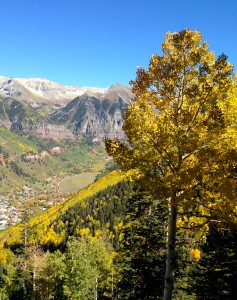
06 Oct EcoAction Partners: Mountain Facts, Aspen Leaves
 Editor’s note: Hilary Lempit of EcoAction Partners launches a new series called “Mountain Facts” that is all about answering your questions about the environment and sustainability. The first question: What makes the aspen trees turn colors?
Editor’s note: Hilary Lempit of EcoAction Partners launches a new series called “Mountain Facts” that is all about answering your questions about the environment and sustainability. The first question: What makes the aspen trees turn colors?
This week is the prime time for leaf-peeping. The cloudless, crisp blue sky contrasts perfectly with golden and orange aspen leaves and the snow-capped peaks of the San Juans. Head outside to enjoy the gorgeous fall weather and the vibrant falling leaves – and study up beforehand using EcoAction Partners’ Mountain Fact of the week!
Did you know the fiery colors on our aspen trees are caused by the changing amounts of sunlight and chemical reactions inside leaves?
During spring and summer, leaves appear green due to a pigment called chlorophyll, which masks the colors of other pigments in the leaves, anthocyanins and carotenoids. Sunshine is required for chlorophyll production, but as we move farther away from the sun during fall, that production slows down. When green-pigmented chlorophyll begins to break down, the colors in the other leaf pigments are revealed: yellow for leaves with lots of carotenoids, red for leaves with anthocyanins, and orange for the leaves with a balance of those two pigments.
Because anthocyanin production requires a whole lot of sunlight, during wet and cool years we don’t see as many fiery red aspen leaves as in drier years.
Catch the drama of fall in the San Juan Mountains. Take a relaxed bike ride down valley on the bike path from Telluride, or meander along the Dolores River to see stands of huge, golden-leafed cottonwoods.
Curious about Telluride’s natural surroundings? Please submit your questions for future Mountain Facts to info@ecoactionpartners.org.


Sorry, the comment form is closed at this time.